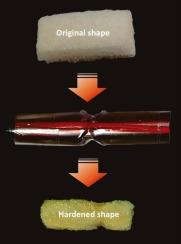用于形状固定和微创生物医学应用的乙醇软化形状记忆聚氨酯的快速水触发硬化
IF 7.9
2区 材料科学
Q1 MATERIALS SCIENCE, MULTIDISCIPLINARY
引用次数: 0
摘要
本研究提出了一种乙醇软化形状记忆聚氨酯(SMPU)的快速水触发硬化策略,包括热固性泡沫和热塑性聚氨酯(TPU)薄膜/膜。SMPU泡沫一旦被70%的乙醇软化,就变得高度可压缩,可以进行微创输送。随后浸泡在水中有效地去除乙醇,并在几分钟内恢复泡沫的机械刚度,杨氏模量在5分钟后从0.001 MPa(软化状态)增加到0.8 MPa以上,远远超过单纯的空气干燥。这种乙醇-水交换机制使形状固定不需要热活化或有毒溶剂。该概念在TPU薄膜和静电纺丝膜中得到进一步验证,在类似的处理下,它们表现出局部和可编程的形状恢复。在血管幻影模型中,SMPU泡沫显示出硬化后动脉瘤几何形状的适形填充和安全固定。这些发现提示了一种适合于栓塞和其他微创生物医学应用的溶剂反应性、生物相容性平台,为传统的形状记忆方法提供了一种更安全、更快速的替代方案。本文章由计算机程序翻译,如有差异,请以英文原文为准。

Rapid water-triggered hardening of ethanol-softened shape memory polyurethane for shape fixation and minimally invasive biomedical applications
This study presents a rapid water-triggered hardening strategy for ethanol-softened shape memory polyurethanes (SMPU), including thermoset foams and thermoplastic polyurethane (TPU) films/membranes. The SMPU foam, once softened by 70 % ethanol, becomes highly compressible for minimally invasive delivery. Subsequent immersion in water effectively removes ethanol and restores mechanical stiffness of the foam within minutes, with the Young’s modulus increasing from 0.001 MPa (softened state) to over 0.8 MPa after 5 min—far surpassing air drying alone. This ethanol–water exchange mechanism enables shape fixation without the need for thermal activation or toxic solvents. The concept is further validated in TPU films and electrospun membranes, which exhibit localized and programmable shape recovery under similar treatment. In vascular phantom models, the SMPU foam demonstrates conformal filling of aneurysmal geometries with secure fixation post-hardening. These findings suggest a solvent-responsive, biocompatible platform suitable for embolization and other minimally invasive biomedical applications, offering a safer and faster alternative to traditional shape memory approaches.
求助全文
通过发布文献求助,成功后即可免费获取论文全文。
去求助
来源期刊

Materials & Design
Engineering-Mechanical Engineering
CiteScore
14.30
自引率
7.10%
发文量
1028
审稿时长
85 days
期刊介绍:
Materials and Design is a multi-disciplinary journal that publishes original research reports, review articles, and express communications. The journal focuses on studying the structure and properties of inorganic and organic materials, advancements in synthesis, processing, characterization, and testing, the design of materials and engineering systems, and their applications in technology. It aims to bring together various aspects of materials science, engineering, physics, and chemistry.
The journal explores themes ranging from materials to design and aims to reveal the connections between natural and artificial materials, as well as experiment and modeling. Manuscripts submitted to Materials and Design should contain elements of discovery and surprise, as they often contribute new insights into the architecture and function of matter.
 求助内容:
求助内容: 应助结果提醒方式:
应助结果提醒方式:


